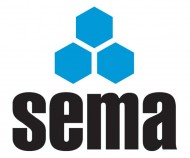Our first question for this month asks whether the Safe Working Load (SWL) should include the weight of the pallet, then our final question considers the use of run spacers and asks should these be connected to back to back racking.
 2 tonne or not 2 tonne
2 tonne or not 2 tonne
Q. We have racking installed on our site and the signage states there should be 2 tonne on each beam. We receive ingredients in 1 tonne loads which exclude the weight of the pallet. Is this okay or do we have to take some of the raw ingredients off the pallet. The signage seen always states 2 tonne per beam, would this include the pallet or not?
A. We trust you mean 2 tonne per pair of beams which is two I.0 tonne pallets per pair. Amongst other things the information given on the load notice is the Safe Working Load (SWL) per pair of beams and the safe bay load. This information is the actual load that you can put on the racking i.e. total weight of goods + pallet. A pallet will typically weigh about 20kg or a little more (depending upon the type of pallet and moisture content of the timber etc.) so this is about 2% or so of the weight of the goods and needs to be taken into account to ensure that beam overload does not take place
SEMA does not hold SWL data and you will have to obtain this information from your racking supplier. The SEMA website gives a list of SEMA members www.sema.org.uk/ about_mem.asp who should be able to help you.
Back – back racking and run spacers
Q. Could you clarify for me whether or not the back to back racking we have installed needs to be connected with run spacers, we have conflicting advice from 2 different installers and I wanted to clarify whether or not we need them? The height is 4m, the highest load will be 3m and they are in 30m runs.
A. The SEMA recommendations in place at the time when this Speedlock Mk3 racking was made was that row spacers should be fitted adjacent to bracing note points at centres not greater than 2.5m with one at the top of the rack and one at the bottom of the upright. Plainly however as row spacers cannot be fitted to single runs of racking the argument goes why should they be fitted to two single rows built in a back to back situation?
The answer to this is that the row spacer will add a certain amount of resilience to the structure in the event of an accident. If a front upright is damaged and becomes ineffective then some of the load will be transferred through the row spacer to the rack behind the one concerned, and if the user is lucky, a collapse will not occur that otherwise would have done.
The SEMA view is that row spacers are relatively cheap components that provide a degree of extra security for the warehouse and those working in it compared with when not present. SEMA therefore recommend that they should be fitted however will agree that structurally they cannot be justified as if a single run will stand up then so will two single runs located adjacent to each other.
We have heard it argued that omitting these items is a cost saving measure as it not only saves the cost of the row spacer but also the labour cost of installing them. SEMA‘s attitude however, is that you only discover the value of these items when you have an accident!
Finally Health and Safety Executive publication HSG 76, Warehousing and Storage a Guide to Health and Safety, (free download from HSE web site) states “Double sided runs should be connected and spaced using suitable run spacers “Page 79 clause 634. If you are not following HSE guidelines then you do need some good justification as to the ‘why’ in the event that you need to explain the circumstances of an accident taking place.
SEMA is delighted to be working with WLN on the storage Question and Answer Column which is published in WLN on a monthly basis.
A date for your diary
The 2015 SEMA Safety Conference has been scheduled for Thursday, 5 November; the venue will be the National Motorcycle Museum, Solihull. For full details and a booking form contact SEMA at enquiry@sema.org.uk
SEMA Technical Enquiries
We hope you find the above articles, and those in previous editions, interesting. If you have a query send it to us by fax or email and we will do our best to have it answered by one of our technical experts.
Rack Safety Awareness and Inspection Courses
SEMA runs a one-day safety course on Rack Safety Awareness and Inspection. These courses are aimed at end users, giving an in-depth look at the need for inspections, how to conduct an assessment and what actions to take when this is completed.
Approved Rack Inspectors Qualification
This qualification is aimed at professionals who conduct rack surveys as an integral and significant part of their duties. It involves delegates in undertaking an in-depth SEMA Course, together with an examination and practical assessment. CPD will be an important part of the qualification, demonstrating to end users that SEMA Approved Inspectors maintain a high professional standard.
SEMA Publications
SEMA has 26 publications in stock – Codes of Practice, ‘Guides’ and European documents – all of which are available from our Offices.
SEMA USERS Club
SEMA runs a USERS Club designed to be of benefit to purchasers and users of storage equipment. Members receive newsletters, access to specialised events and discounted rates on publications and codes of practice.





Comments are closed.